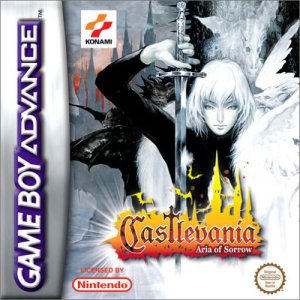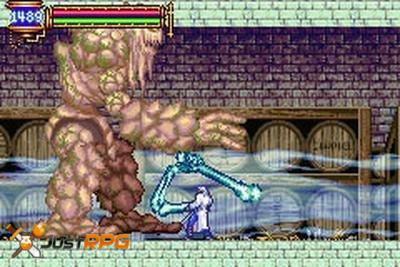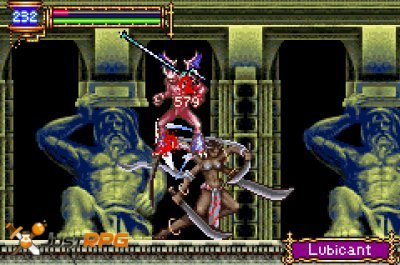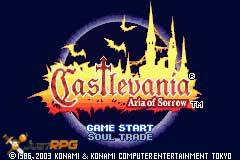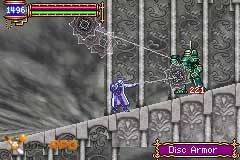Castlevania: Aria of Sorrow is the third installation of the Castlevania series on the Game Boy Advance. Players take control of Dracula’s benevolent reincarnation as he attempts to find out what is going on and why he is being drawn to the castle that was his home in a former life.
Full Review
Castlevania: Aria of Sorrow Review
By, Nicholas Bale
Backdrop
.hack Part 1 Infection (Dot Hack) begins with a bang. Something disastrous happens to your character‘s real world friend, while innocently playing a 20 million-subscriber base, wildly popular online RPG game (MMORPG), The World. To unravel the mystery of your friend’s misfortune, you become an online, ingame rogue hacker, exploring every corner of The World, even some virus-infected ones.
The hero is armed with the special skills of Data Drain and Gate Hack, and some colorful, talented fellow adventurers to fill the two other available party slots. Different adventurers must accompany you depending on the plot‘s development. You have some control over the others in your party, including upgrading them through trades or gifts. You can play only a single class, Twin Blade. Other characters are from different classes, with varied strengths and weaknesses, from a mage type (Wavemaster) to a bully (Heavy Axeman).
Gameplay
Gameplay takes place in three principal areas – towns, fields, and dungeons. Towns house The World’s servers. There, the player can save the game, buy magic scrolls and useful and unique items, store items, buy equipment, and talk and trade with lots of other players in character online. One town has an unusual ranch to check out, a patent homage to an enduring feature of just about every Final Fantasy.
The town’s Chaos Gate provides instant teleportation to a particular wide-open Field, containing monster encounter hotspots, a mystical spring, treasure, and lots of mysterious food. You enter three distinct keywords, some known at the game‘s onset, and others learned through play. Whatever keywords are entered, the difficulty level of the destination is helpfully revealed. This prevents a low-level party from being massacred. Once the keywords are entered, you travel through the Chaos Gate. (You can enter specific keywords learned to continue the plot, do side quests, or do unlimited exploring. Or, you can instruct the Gate to enter random keywords, and take your chances. There‘s also an option to enter any keywords you wish from a word list.) Every Field houses a single Dungeon. The dungeons, where you spend much of the game fighting for your life, are not overly large in size, and always range between three and five average levels.
Many have compared Dot Hack to Phantasy Star Online Episode I and II (PSO) on the Gamecube. Let us gently discredit this. We feel Dot Hack has far better graphics than PSO. The Fields and Dungeons contain many colorful, over stylized backdrops and settings, including weather effects. Dot Hack’s monsters resemble the beautifully-drawn monsters of the later Final Fantasy’s. Dot Hack’s world is gigantic with a seeming infinite number of locations to explore. PSO’s world is relatively small, and plot is threadbare, with meaningless, though fun, side quests, which instill no enthusiasm in the player. Dot Hack’s plot is deep and complex, with each subplot advancing the story just a little bit further. (Remember though, the end of this game in no way comes close to wrapping up the story, to be completed in the three games to be released later this year.) One visual treat, however, was lifted directly from PSO – the cascading rings that accompany the teleportation of characters to and from different areas.
Combat
Dot Hack’s combat engine can best be described as modified real-time. Much like the action-RPG, Kingdom Hearts, button mashing can be effective to beat monsters. Monster combat icons appear as large yellow twirling landmarks. As you approach, the landmark dissolves, monsters come at you big-time, and, undoubtedly, players will feel a healthy adrenaline rush. Some of Dot Hack’s many monsters do not stand around waiting to be pummeled, rather some you need to catch. Dot Hack lets you turn combat almost into a turn-based affair. The player needs only to hit Triangle in the middle of battle to pause the game instantly. From there the player can give orders to the others in the party, anything from healing someone, reviving another, casting a spell, designating a target monster. Without jeopardizing your party from the hailstorm of monster blows, combat becomes a calmer, more strategic, experience. This will help the many action-challenged. Camera angles play a big role in successful combat. You must be facing a monster to do any damage. As in many games, manipulating opposing environmental elements, like fire vs. water, is a key to successful monster combat.
Dot Hack’s cyberspace setting provides a wealth of Wow-inducing outbursts. The Data Drain option in combat is a great example. When a monster’s approaches zero, the player can Data Drain to reduce a horrendous, gigantic steel robot, for example, into a sniveling, puny monster, easily defeated with a single blow. Data Drain always results in a nifty, rare item or essential Virus Cores so you can Gate Hack areas of The World now closed, but needing investigation. One bad side effect – if you defeat, a Data Drained monster, but a single experience point is earned. One REALLY bad side effect – if you Data Drain too often without giving the skill a rest, you may overload and explode. Game Over. In the case of Boss monsters, Data Drain works the same, but what remains is no sniveling puny monster, but a full-blooded slightly less tough monster. All of this makes for interesting and captivating combat, a large part of the game.
Fresh Features
Dot Hack is replete with new and interesting features that kept us riveted.
To start, the entire background and story of a real world gamer becoming a rascal hacker, penetrating deep into a virus-infected online game, is quite novel. Combine this with Dot Hack’s emulating the look and feel of an online game universe. (Message traffic on the web shows many gamers mistakenly believe Dot Hack is a real online MMORPG, along with monthly fees! No real Internet connection is required.)
Just like in the real word, Dot Hack replicates your excitement level when “New” appears before a popular forum or on your email screen. Some of the game involves receiving emails as the plot develops, as well as new, crucial information surfacing on The World’s Board. (Look out for emails challenging you to a strange game of Tag.) The online game world looks very familiar with a bunch of characters wandering around the game’s towns, with the ubiquitous balloon icons talking typical “trash” to each other, even criticizing “newbies“.
Combat grippingly called for surprisingly strategic decision-making to succeed, not related to the usual attack or defend choices. Do you go for experience and upgrade your character or try for some special equipment or a Virus Core, vital to Gate Hacking? The innovative control of other party members became second nature to us after some practice. The game rewards a player taking chances, like entering a Field or Dungeon rated 5 levels above the player’s current level. On the other hand, the game scoffed at players entering areas much lower rated the their current level, by awarding negligible experience points for victory.
Dot Hack takes progress reports to a new level, by slowly unlocking books that contain much in the way of statistics and information. There’s even a monster compendium with tips for defeating them.
Some might complain about the minimal “Save Game” ability, but we thrived on it. You explore a very hostile cyberspace environment without the facility to save. Only in a server-hosting town is saving possible at the local Recorder. We may be a solitary voice in the Wilderness, but we like this throwback to the good old RPG days. Those of you old enough to remember the Wizardry series, may recall those fingernail-biting multi-combat treks back to the Castle just to save the game. In case you’re really stuck deep in a dungeon, a common item will teleport you to the outdoor field, from where you can simply gate back to town from the command menu.
Many pieces of equipment come with distinctive powerful attack, healing, and status skills, essential to combat dominance. The player must tradeoff whether to equip something that will raise defense or offense or something less vigorous that lets you use a powerful skill. Trading is the most successful way to upgrade equipment.
In a first, Dot Hack comes with a 45 minute anime video. This gives some great background on what’s going on in The World, as well as provide clues for completing the game. In a nice twist, voiceovers for game speech can be set for Japanese or English presentation. Listening to the authentic Japanese voices really keeps you glued to the game.
Though some may scoff at what follows as meaningless, we liked the game’s unlocking of some nifty new “toys” to like, some only available when the game is cleared. You can unlock many different background music play lists. Tired of creepy tunes, just switch to something more upbeat, or futuristic. Just like real world gamers, who constantly change their desktop wallpaper, new and different wallpapers are unlocked along the way. Some are concept art of characters, while others are full blown anime renditions of the characters. This makes for great fun, and seems to pump additional energy into the game. As you progress over a dozen special cut scenes or movies will become viewable after defeating the game.
Though Dot Hack’s extras and new wrinkles enhance the RPG game experience, much of the gameplay will ring true to those who enjoy RPG‘s. Expect plenty of exploration in a huge 3D world, frequent monster combat, tons of treasure to earn and discover, upgrading your character’s weapons and armor, and needing to level before tackling pivotal story dungeons. The status screens for the characters and all equipment are well laid out and easy to grasp.
Time for Completion
Game length in hours always concerns many purchasers. A short RPG normally takes a lot of flack, and many online are asking about Dot Hack‘s time for completion. (Some have questioned whether Bandai should have released a single 80 hour game for $50, rather than four 20-hour games for $200 for a single story. This matter is beyond the scope of this review, but our high opinion of this game as a standalone is obvious.) Our experience, playing the plot without doing side quests or extra exploration, is in the 12 to 15-hour range. Players side-questing and extensively exploring, aside from the main plot, can expect to spend 25 hours to complete the game. You can even continue to advance your character, after game completion, to get a jump start on Part 2 due in May. In the next game, your character can be imported from Part 1.
Furthermore, imagine trying to explore every nook and cranny of the fields and dungeons accessible by a large number of 3-word combinations. Doing that would put the game in the 50-hour range, if not more. However, at a certain point, new items dry up, and a single experience point is earned for any defeated monster, no matter how tough.
Shortcomings
While, as is evident above, there is much to recommend in Dot Hack, certain concerns to varying degrees deserve mention.
From the “Why oh why did they leave this out?“ File. Pregame game board traffic and information about the Japanese version released months ago had many salivating for replaying the game in “parody” mode. This mode apparently converted all Dot Hack’s game world characters into satirical comedians. Sorry to say, this highly-anticipated feature is missing from the version released here.
The game requires massive amounts of button pressing. Every item or treasure uncovered from combat victories or exploration (opening chests, searching expired adventure remains, collecting food for Grunty’s, as examples) must be confirmed with a button press. When there could be 50-100 such occurrences in a single dungeon or field, over the course of the game, finger cramps seem inevitable. Baldur’s Gate: Dark Alliance also required lots of bashing for buried treasure and chests, but the items literally flew into your inventory, a much better way to handle this.
The manual is woefully terse and lacking in some crucial information and guidance. While the ingame tutorials fill in many of the gaps, one extremely important gameplay feature is missing from both the manual and tutorials – instructions on control your characters directly during combat.
Final Word
We got a kick out of Dot Hack. The feeling of “just one more dungeon” dominated our lives for the 3 days to completion. The engaging environment held our attention without much effort. The strategic nature of combat, plus the convoluted plot kept us going for hours on end. The constant unlocking of both frivolous and important gameplay features created a “what’s next” anticipation. Now, if I could only read Japanese better, Dot Hack Part 2 is already out in Japan!
Final Grade: B
Castlevania has taken a dramatic approach at the series with the addition of Aria of Sorrow to the GBA lineup of Castlevania games. The series is changed dramatically with the addition of RPG elements within the game such as experience levels, inventory, and more!
Continuing in the ‘musical’ theme of the recent Castlevania games (Harmony of Dissonance, Symphony of Night), Aria of Sorrow is a colorful new RPG-style Castlevania. The game takes place in the year 2035, but don’t start envisioning laser-wielding skeletons or cyborg demons, Aria has stayed true to the old theme of Castlevania games. You’re still wandering through the dark halls of Dracula’s castle…only this time, the old bat is dead. That’s right, he’s truly dead. You are Soma Cruz, an ordinary guy who gets sucked into an eclipse of the sun, where you discover Dracula’s castle. Now, it seems that in the year 1999, Dracula was destroyed, and to make sure he stays dead, the slayers put his castle in the solar eclipse, where, for some reason, Dracula has no power. However, there is still evil in the castle…
What I like about this Castlevania is that the story develops as you play the game. As the extremely feminine Soma explores the castle, he will talk to a number of people, many who will help him out, some who will not. While the story is not edge-of-your-seat, it added flavour to what might’ve been a pretty bland action-RPG. The conversation, however, is extremely poor. It seems directly translated from the Japanese version of the game, and it’s very odd to read some of the things that these characters say. I’m not saying it’s poorly translated, I just say that just because the literal translation is “I will be the person that will destroy you!”, it wouldn’t be a bad choice to change it to “I’ll kill you!”. To add more to the game, there are three different endings, two good and one bad. It all depends on how you fight the final boss, who *gasp* isn’t Dracula! Well…he kind of isn’t…but I won’t give away any more. And while you aren’t part of the Belmont family, you do encounter the line of vampire hunters somewhere within the game…
Apparently this Soma has some pretty nifty powers. Within the game, you have the ability to steal the souls of nearly all of the enemies, even bosses. Each time you steal a soul, it grants you a power. There are three different kinds of souls: yellow, blue, and red. The red souls are basically special attacks that you execute by pressing up and attack. The yellow souls are continuous and are often bonuses to your statistics. The blue souls are called “Guardian” souls, and are used by pressing the R button. These souls can do things such as turn you into a bat, give you an ability to fall slowly, and more. There are also souls that grant you special abilities. These souls are not found in enemies, but are often rewarded after defeating a boss or exploring a large area. There are a total of six ability souls to collect, and most of them aren’t even required to beat the game, they just add some fun (like the ability which allows you to skyrocket about six screens straight up).
The inventory system is also well implemented. Soma can equip one weapon, one piece of armor, and one accessory. There are basically three kinds of weapons, the kind that stab straight out, the kind that make a cutting arc, and the close-range kind. The game designers decided to back away from the conventional whip-weapons, and instead you use swords, daggers, and since this is the future, guns. Yes, if you look hard enough, you can find a 9mm pistol and a plasma rifle. The rest of the weapons are pretty standard fare, increasing your attack, while some weapons increase other stats as well. It’s the player’s choice of whether he wants a quick-attack weapon that sacrifices strength or a slower weapon that is harder to use but raises defense as well. The armor is much like armor in any game, raising defense while some armor raises other stats as well. The accessories are interesting because you can get accessories that range from a ring that allows you to collect more souls to a cape which raises every stat by one. The only problem is the lack of a paper-doll system. For those who don’t know, that means that when the character equips a cape, you should see a cape trailing behind him onscreen. It’s kind of disappointing to see Soma in the same feathery jacket, black shirt, and jeans all the time. Well, I guess even the GBA has its limits.
The graphics in this game, like many GBA games, shine. Despite the gloominess of Dracula’s castle, the colors are bright, and objects are distinct from the background (i.e. they don’t disappear into the background). The enemies are also quite distinct. Instead of facing a blob here and an oddly shaped humanoid there, you can tell that this is a zombie, this is a bat. The GBA’s capabilities are used fully here, as I remember the background for when you are atop the castle, because it’s a gray, swirling sky that almost looks three dimensional. The folks at Konami have really done well in this department.
This game was pretty fun. I kept playing and playing, if not to beat the game, then to see what extra goodies I could find in every nook and cranny of Dracula’s castle. There is a map that displays how much of the entire castle you have explored. I played a good 25+ hours and I still only explored about 90% of it. Now, maybe that’s because I played a lot of areas over, trying to get every soul, which is another goal that someone can meet. There is a dossier of every enemy in the game, its weaknesses, strengths, and whether or not you have taken its soul. I just couldn’t get them all.
One of the greatest problems with the game is that it’s just too easy. Maybe that’s just me, maybe I was lucky, but I couldn’t find very much of the challenge that existed in previous Castlevania games. I don’t want to blame the leveling-up feature of the game, but it’s part of the reason. The game is fun, like I said, but I wanted more. I blazed through area after area, being defeated only by extra-strong enemies and bosses. Speaking of bosses, they are well designed and present quite a challenge, unlike most of the enemies in the game. Some of the enemies are just really, really, really annoying, like the harpies that are just out of reach of your weapons. At least there is a lot of replay value. Even when you’re done with the game, you can link up with someone else to trade souls that the two of you might have missed.
Well, it’s a bold new step where no Castlevania has gone before. It’s succeeded. The controls are simple, the gameplay enjoyable. I will be looking forward to more games like this.
Final Verdict: 90%

